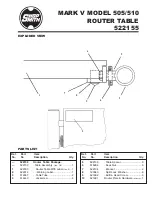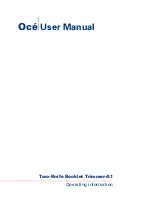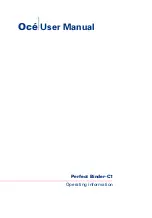
MARK V MODEL 505/510 ROUTER TABLE
522155
Page 6
of the Mark V Router Table. It can then be
easily and safely reached during opera-
tions.
• The Router switch must be able to stay in
the “on” position without being held by
hand. It also must easily switch off as
needed.
• The Shopsmith Accessory Switch is rec-
ommended if the router motor switch does
not meet the above criteria.
SAWDUST AND CHIPS
Sawdust and chips can be a fire hazard and
breathing sawdust can be a health hazard. The
sawdust from some woods is toxic. To help
protect yourself from sawdust:
•
Attach the MARK V Model 505/510
Router Table to a dust collection system.
• Or wear a close-fitting dust mask. Clean
or replace the filters in the mask regu-
larly. Also, open a window or use a fan to
ventilate your shop.
MOUNTING ROUTER BITS
MOUNTING ROUTER BITS
MOUNTING ROUTER BITS
MOUNTING ROUTER BITS
MOUNTING ROUTER BITS
• Turn off and unplug the Router before
mounting router bits.
• Follow the recommendations of the Router
manufacturer as to the sizes and types of
router bits to use.
• Make sure the router bit is secured prop-
erly in the collet. Loose bits could work
free and cause serious injury. Insert the
bit fully into the collet and retract it about
1/8".
• Be sure the bit is positioned with the
cutting edge facing to the right.
• Listen for chatter or signs of looseness at
start-up. If you hear, see or suspect prob-
lems, stop the tool immediately, unplug
it, and check the tool thoroughly. Correct
any problem before proceeding. If you
are unable to locate the problem, you can
contact your Shopsmith Service Repre-
sentative or store personnel for advice.
Never operate the Mark V Router Table
if it is not functioning properly.
• Keep bits clean, maintained and sharp.
• Don’t try to make your own collet adapter
to hold different sized bits. Balance is
important at high speeds, so always buy
appropriately sized collets.
TYPES OF ROUTER BITS
Router bits come in a wide variety of shapes
and sizes designed to be used at very high
speeds. The part of the bit mounted in the
router chuck is called the shank and the
rounded extension beyond the cutter on some
bits is called the pilot. The cutting edge of the bit
is called a flute. Router bits have one, two or
three flutes and the more flutes there are on the
bit, the more cuts that can be made per minute.
A higher number of flutes reduces the load on
the motor and produces a smoother cut.
Quality bits are made of high-speed steel, solid
carbide or carbide-tipped steel. High-speed steel
bits are heat treated for extra hardness and to
hold keen cutting edges. Carbide bits (solid or
tipped) are the finest bits available today. Al-
though more expensive, they will out last high
speed steel bits at a 15 to 1 ratio on softwoods
and are high recommended for use on hard-
woods, plastic laminates, plywood and par-
ticle board.
Router bits are generally classified into four
different categories: grooving bits, edge-cut-
ting bits, panel bits and laminate and veneer
trimming bits.






























